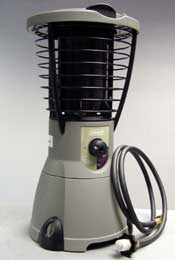Tiny Mosquito
Mosquito Traps
Effective and unobtrusive, mosquito traps can create a more comfortable and welcoming atmosphere in your backyard. Their power to attract and kill flying insects will reduce, and in some cases, virtually eliminate the mosquito population around your home.
New innovations in the mosquito trap industry include cordless models, light construction models, and others with wheels for maximum portability.
 How
do they work?
How
do they work?
Mosquito traps use various attractants to bait insects, some of which
are listed below:
- CO2 (generated by propane)
- Octenol
- Moisture
- Thermal Imaging
- Light (generally UVs)
Once lured in by the attractant, the insects are drawn into a vacuum and trapped in a net, where they dehydrate.
Mosquito Trap Specifications
There are some propane-based mosquito trap models on the market and others
that are sold as propane alternatives.
Propane is the most effective way to produce CO2, which is the main attractant in many mosquito traps. It is generally combined with secondary attractants in order to create potent insect bait. Propane-based traps work around the clock and require a tank refill at regular intervals.
Propane alternatives often use a chemical attractant such as octenol, sometimes combined with another chemical that is similar to Lurex. It works well for larger breeds of mosquitoes, such as the Asian Tiger mosquito found in the Southern United States.
Other combinations include a propane primary attractant along with secondary attractions such as thermal imaging (warmth), moisture and octenol.
When should a mosquito trap be used?
In a four season climate, the mosquito population is active when temperatures
rise above 50 degrees Fahrenheit. Hence, when the average temperature
remains around 50 degrees, the mosquito trap should be installed. It can
be turned off when temperatures begin to dip below that level.
In the warm climates of the southern hemisphere, mosquito traps are in use every day, all year round.
Where should a mosquito trap be set up?
Mosquito traps are designed to cover a certain square footage area. Units
should be placed in a convenient spot where you want to create a mosquito-free
zone, usually near an outdoor living space such as a patio. Many choose
to set up a trap at the country cottage, and some farmers opt for one
in the barn.
Ideally, a trap should be installed upwind of any assumed mosquito breeding grounds. It will help reduce the mosquito population by capturing the females that are in search of warm-blooded prey.
Does a mosquito trap require maintenance?
The maintenance of a mosquito trap is fairly simple. It generally involves
filling the propane tank or changing the cartridge/pellet to provide fresh
attractant. Wiping the screen clean with a damp cloth is recommended,
although much of the debris is blown through the screen with little residue
left behind. The unit should not be immersed in water or sprayed with
a hose, due to the risk of electrical shock. Traps typically carry a one
year warranty, but their life expectancy largely depends on proper usage.
Since capturing and eliminating mosquitoes can protect your family from certain serious diseases such as West Nile Virus, mosquito traps have an important function. And because most models do not use harmful chemicals or fogging techniques, they are deemed a safe product that can be used around children. So consider having a wonderful mosquito-free summer!
Home - Mosquitoes - Bites - Control - Diseases - Resources - Site Map